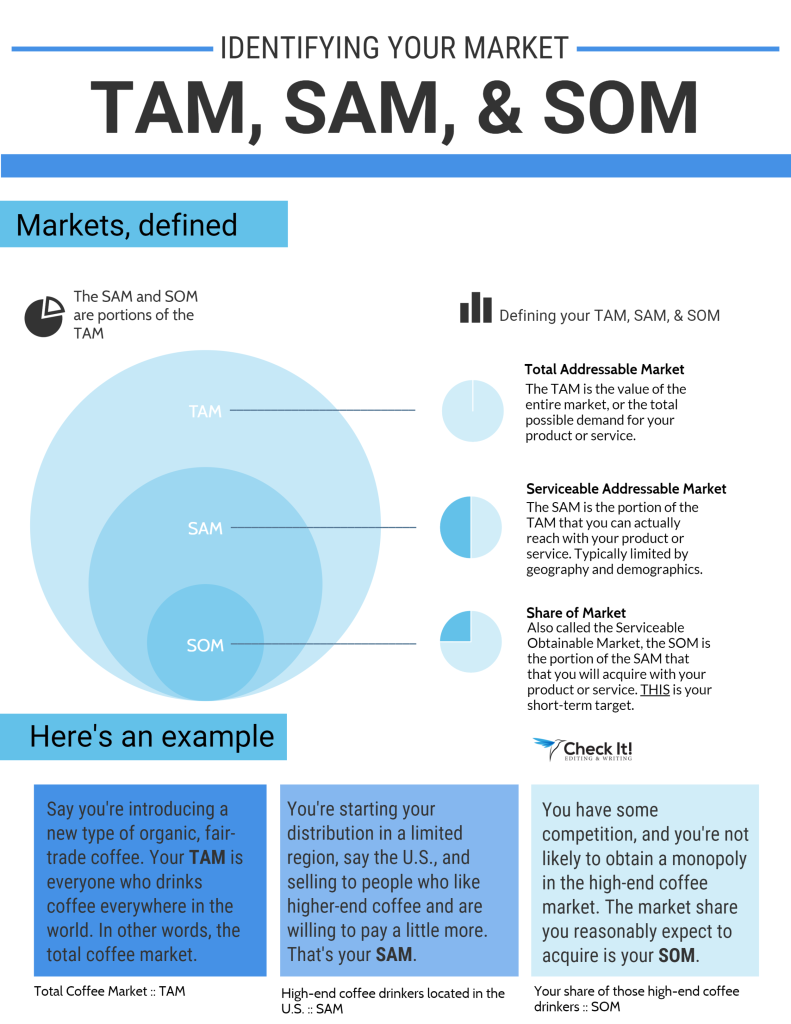Market Sizing
Sally Armstrong
What is Market Sizing?
A market size is made up of the total number of potential buyers of a product or service within a given market, and the total revenue that these sales may generate.
You are often asked to provide a market size for your product or service in an assignment or presentation. Unfortunately, a magical website to help you easily determine your market size does not exist. The ability to calculate your market size will rely on the work you have done to determine your ideal (or target) customer, and your industry and market research.
Calculating your market size is important for a few reasons:
-
It is necessary for marketing planning as it helps you address the unique needs and potential of your ideal (or target) customer.
-
If you are expanding your business to a new region you will need to re-calculate your market size to understand how you can optimize your business for the expansion.
-
Investors will want to understand the market size for your company, and the potential profitability, before making a financial investment.
There are two methods commonly used to calculate your market size: top-down and bottom-up. The top-down method is often considered the easier method but can be viewed as unreliable and overly optimistic. The bottom-up method is more time-consuming as it requires you to do much more research but it often provides a more realistic and accurate assessment of your market size. Check out the Market Sizing Resources below to learn more about the top-down and bottom-up methods.
TAM, SAM, SOM
You will often hear the acronyms TAM, SAM, and TOM associated with market sizing but what do they actually mean?
TAM is the Total Addressable Market which refers to the total market for your product or service. It aims to include every potential customer for your product or service, no matter the competition in the market.
SAM is the Serviceable Available Market which refers to the portion of the market that is within your reach, often determined by geography. For example, the TAM might address a global market size but your SAM would more reasonably encompass only New Brunswick or perhaps Canada.
SOM is the Serviceable Obtainable Market which refers to the portion of the market that is realistically captured within the short/medium term. Determining your SOM will greatly rely on the work you have done to identify your ideal (or target) customer. For example, perhaps you determined that your SAM is within New Brunswick, you would then use the demographic data you compiled for your ideal customer (for example, females aged 24-35 who own a vehicle) to further narrow down your portion of the market in New Brunswick to determine your SOM.
The graphic below provides a useful overview of TAM, SOM, and SOM.

Sourced from: JB. (2020, March 20). A strategy to calculate the market size: TAM, SAM, and SOM. Medium. https://medium.com/is-that-product-management/a-strategy-to-calculate-the-market-size-tam-sam-and-som-cda0a05c77f8
Market Sizing Resources
MaRS Discovery District has a free online course called Introduction to Market Sizing. This 30-minute online course is a practical introduction to market sizing and the fundamentals of market research. Learn the market sizing methods that are often used when describing, analyzing and communicating the size of a market. Note: Students have reported difficulty registering for this course while on-campus. If you encounter this problem, try registering while using your internet connection at home.
The article “Sizing Up: Market Sizing for Your Business” from Towards Data Science provides a concise overview of how to figure out your market size.
The article “Best Way to Do a Market Analysis?” from Inc. compares the top-down and bottom-up approaches used to determine market size.
This Market Sizing presentation from Professor Giovanni Valencia at the Rutgers Business School provides an overview of sizing a market and two case study examples.

